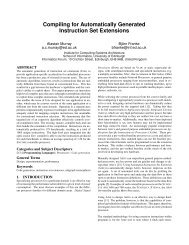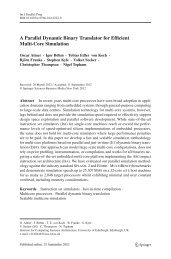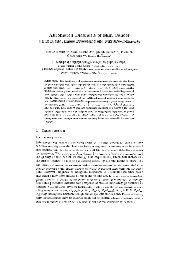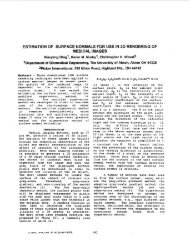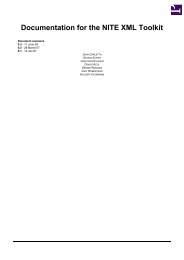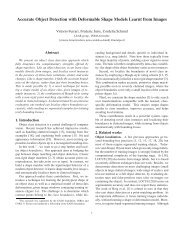WebExp2 Experimenter's Manual - School of Informatics - University ...
WebExp2 Experimenter's Manual - School of Informatics - University ...
WebExp2 Experimenter's Manual - School of Informatics - University ...
You also want an ePaper? Increase the reach of your titles
YUMPU automatically turns print PDFs into web optimized ePapers that Google loves.
3.1.4 Server commands<br />
The server accepts commands while running in the console, allowing the display <strong>of</strong> summary statistics. Available<br />
commands are listed in table 2 To invoke a server command, type a letter at the console followed by return.<br />
Try h first to see the available commands.<br />
Figure 2: Server runtime commands. These are initiated by typing the letter followed by return.<br />
q (Q)uit hard quit — close the server, terminating connections<br />
w (W)ait quit the server, after waiting for connections to close<br />
d (D)ump dump current state records to file (also done automatically before quitting)<br />
i (I)nfo print summary server state information<br />
c (C)onnections show current connection details<br />
e (E)xperiments show all experiments<br />
a (A)ctive show active experiments (those available to clients)<br />
r (R)unning print details <strong>of</strong> running experiments (those with connections)<br />
h (H)elp print command list<br />
This feature was added primarily to allow a clean shut down <strong>of</strong> the server while it is administering experiments.<br />
The quit and wait commands save current records before stopping the server, which is essential for maintaining<br />
experiment completion records, and these commands should be used in preference to ctrl-c for stopping the<br />
server.<br />
The wait command additionally attempts to wait for running experiments to complete before stopping the<br />
server, though this is not yet implemented.<br />
You can also use ctrl-c to perform an unconditional quit. This stops Java instantly and is useful if you have<br />
a problem. However it does not save records.<br />
3.2 Storage <strong>of</strong> results and logs<br />
As clients connect to your server and administer the experiments, information is returned each time a subject<br />
completes an experiment. You should get incrementally numbered files created on your system.<br />
Relative to the release directory, you will have a data directory data/experimenter/experiment for your<br />
experiment, and the following directories will be created within this for storing results: results, subjects and<br />
logs. Each will contain numbered files in the format experiment+number.xml.<br />
Each time someone participates in an experiment, a unique ID is generated to identify that instance <strong>of</strong> the<br />
experiment. The IDs are saved to the uidmappings file in the data directory, along with information identifying<br />
the experiment and the number used to save the results files. Results files are saved in XML format and are<br />
easily processed to extract the information you want.<br />
3.2.1 Results<br />
The results file records all response information for each ‘question’ in the experiment. This ranges from a simple<br />
button press to textual input and timing information. Identifying properties are also output so you know where<br />
each response came from, even with a randomised experiment.<br />
17



